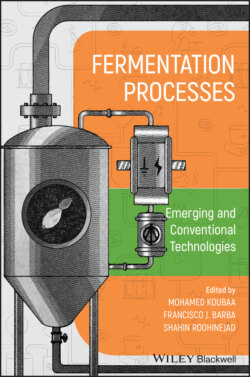Читать книгу Fermentation Processes: Emerging and Conventional Technologies - Группа авторов - Страница 7
Preface
ОглавлениеBioprocesses find many traditional or new applications in the agri‐food, chemical, pharmaceutical, and environmental industries. Enhancing these processes for better production of microbial biomass and/or products has interested many scientists in the last two decades. One of the strategies consists of changing the medium composition or the fermentation parameters (e.g. oxygenation, agitation, temperature, etc.), most of the time via a design of experiment approach. Besides, some emerging technologies (e.g. pulsed electric fields, ultrasounds, high hydrostatic pressure, microwaves, etc.) have shown their efficiency to enhance the fermentation processes. These technologies when applied at high intensities cause cell disintegration and find their applications in bioprocesses, for example, to produce sugar monomers from lignocellulosic biomass. Nonetheless, their application at sublethal levels may induce stress of microorganisms and affect the microbial growth and the formation of the products during fermentation. The beneficial effects of microbial stimulation by emerging technologies include mainly the shortening of the fermentation time, the acceleration of the substrate consumption, and the increase of the microbial biomass.
This book covers the principles of conventional fermentation processes, the major microorganisms used in bioprocesses, their implementation in industrial fermentation processes, the medium condition changes, and the use of emerging technologies for enhancing the fermentation processes. Besides, the mechanisms of action of the above‐mentioned emerging technologies are discussed.
This book is designed to assist scientists working on fermentation processes as well as those working in the food, nutraceutical, pharmaceutical, and beverage industries. The topics covered in this book are suitable for teaching in courses such as bioprocess technology, microbiology, new product development, and food processing.
We gratefully acknowledge the contribution of colleagues from all around the world, the cover designer Mohamed Messaoud, and the professional assistance provided by the staff of Wiley.
Mohamed Koubaa, Francisco J. Barba, and Shahin Roohinejad
